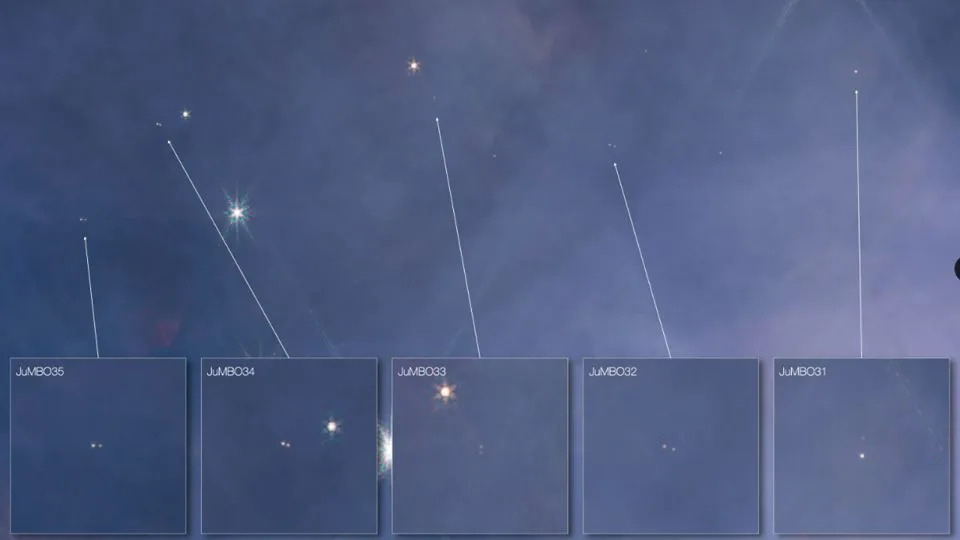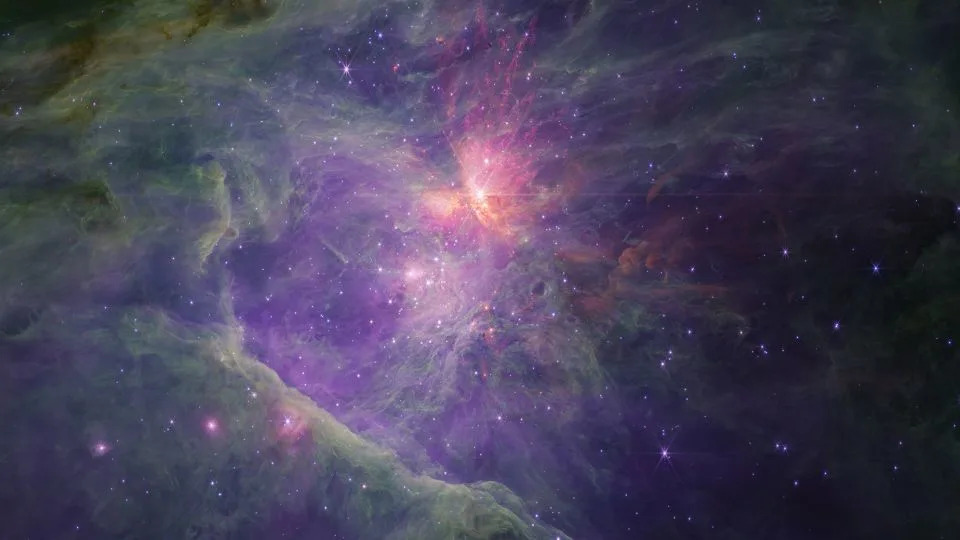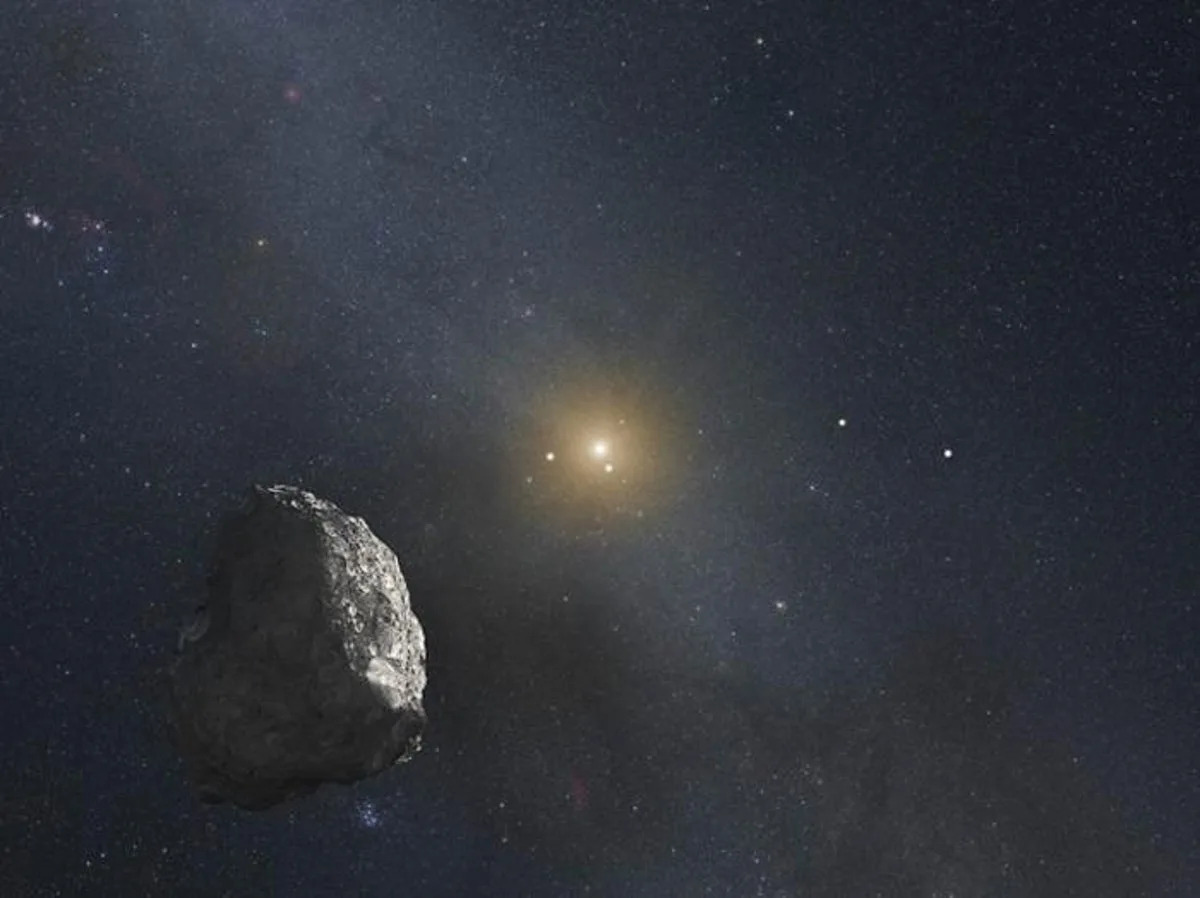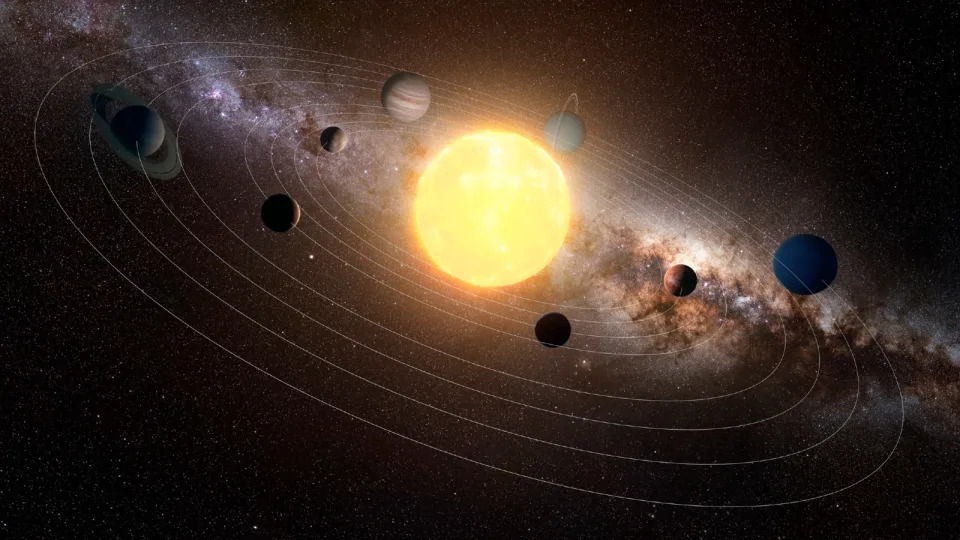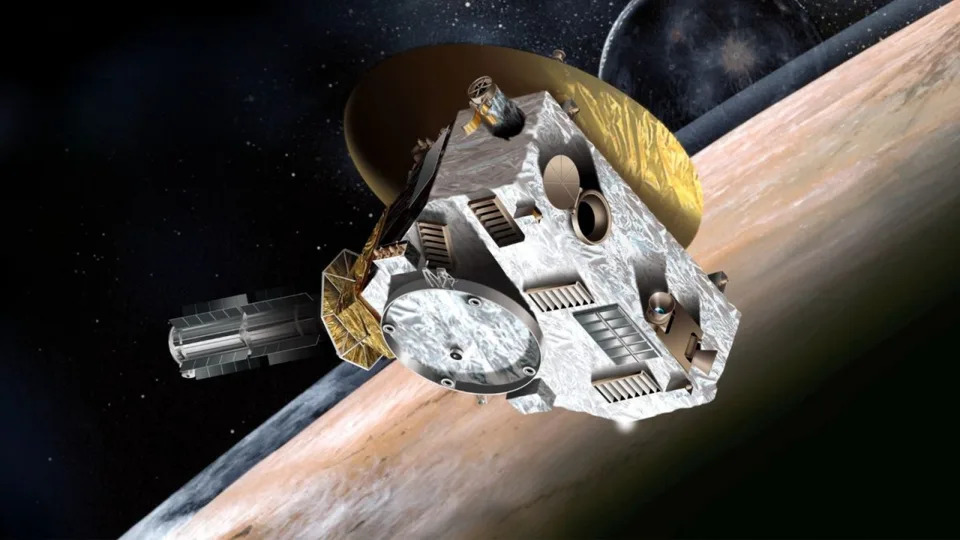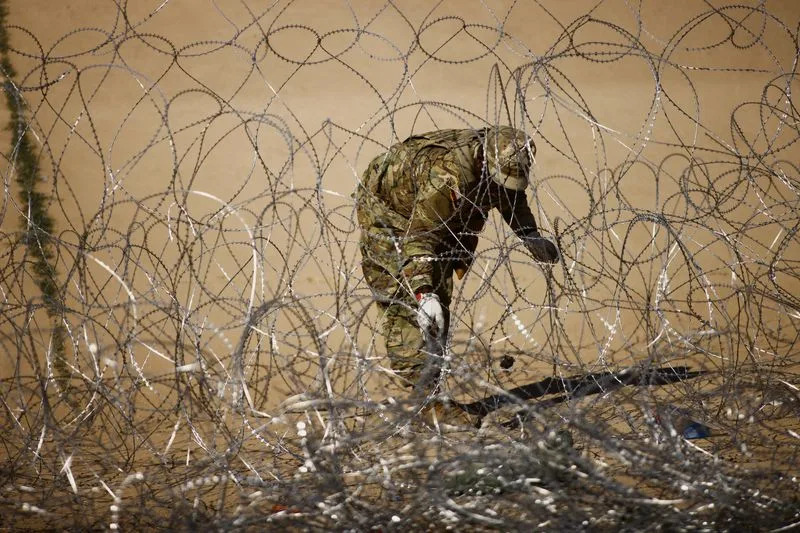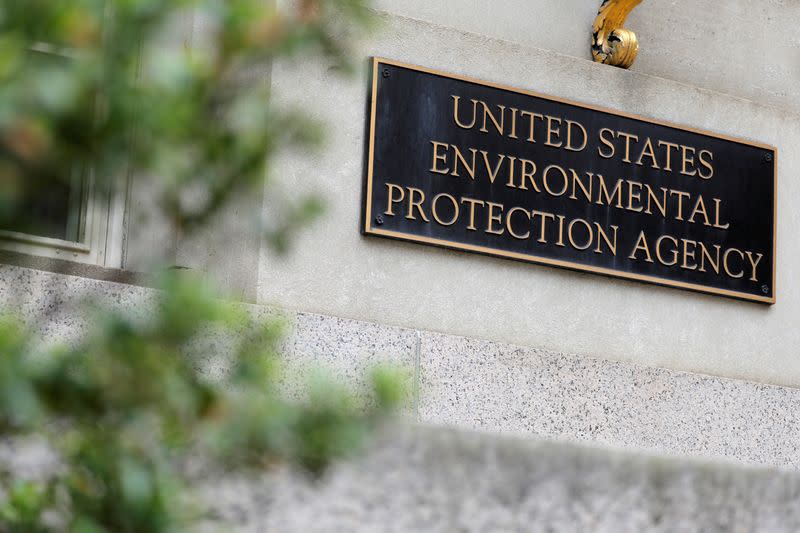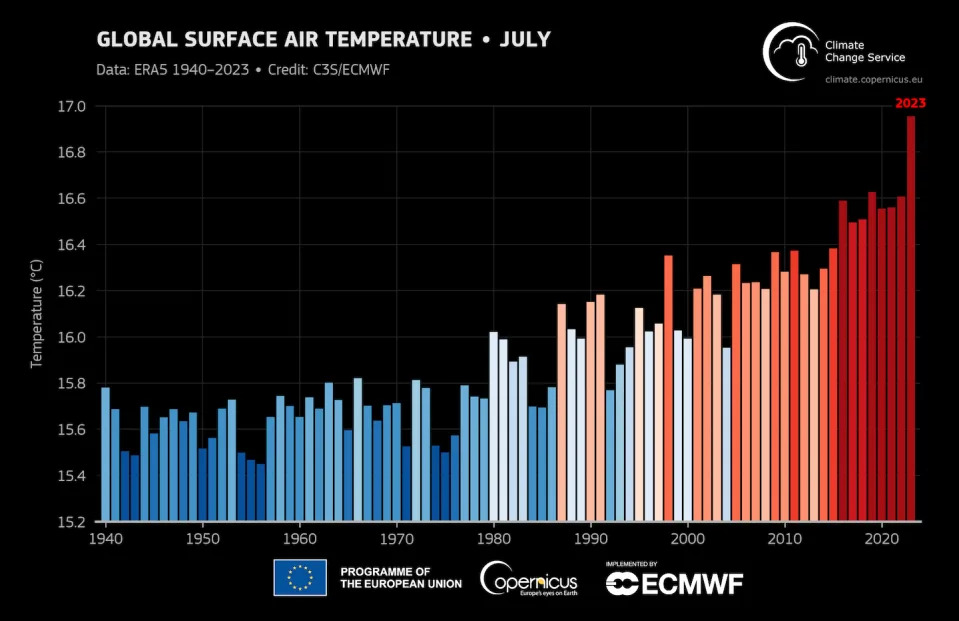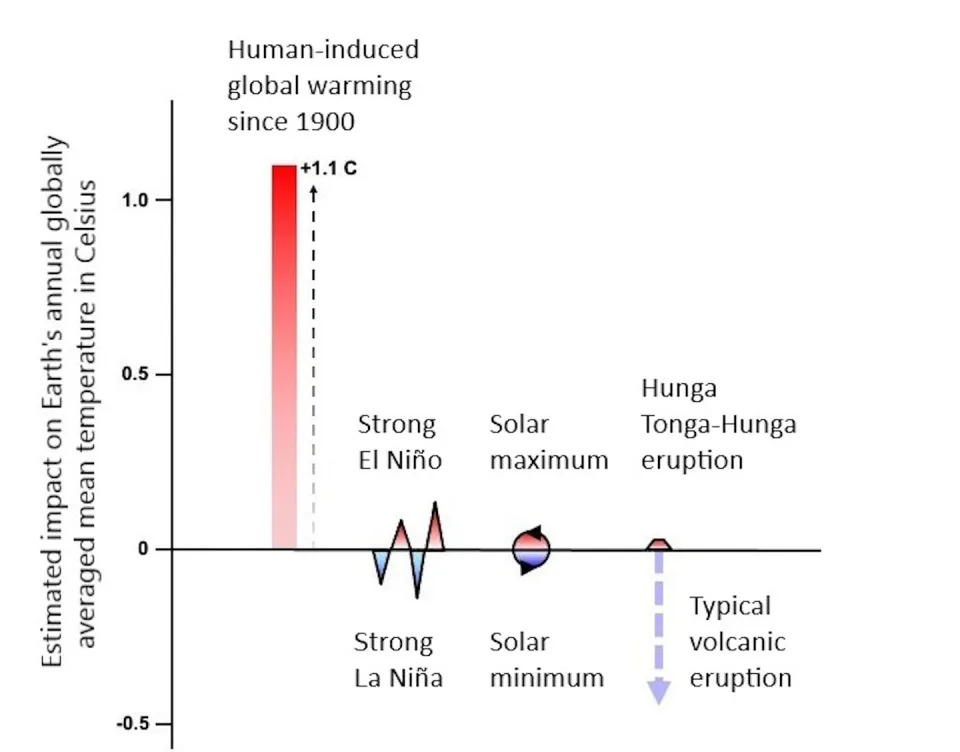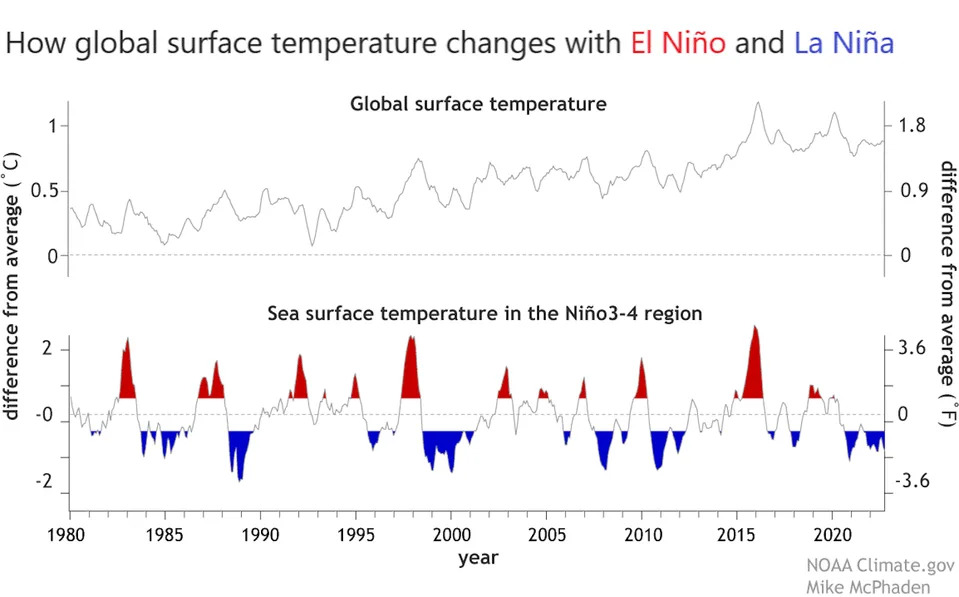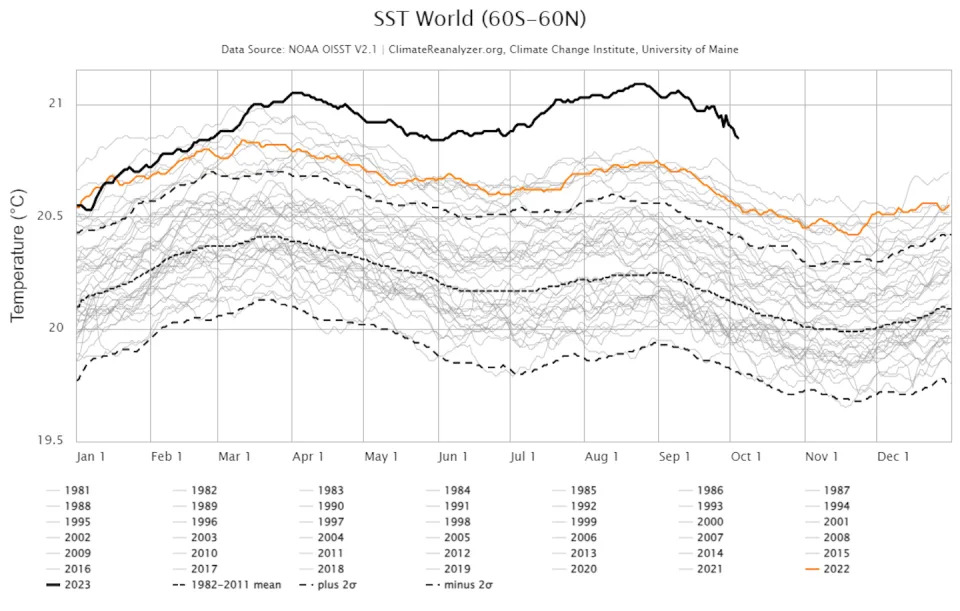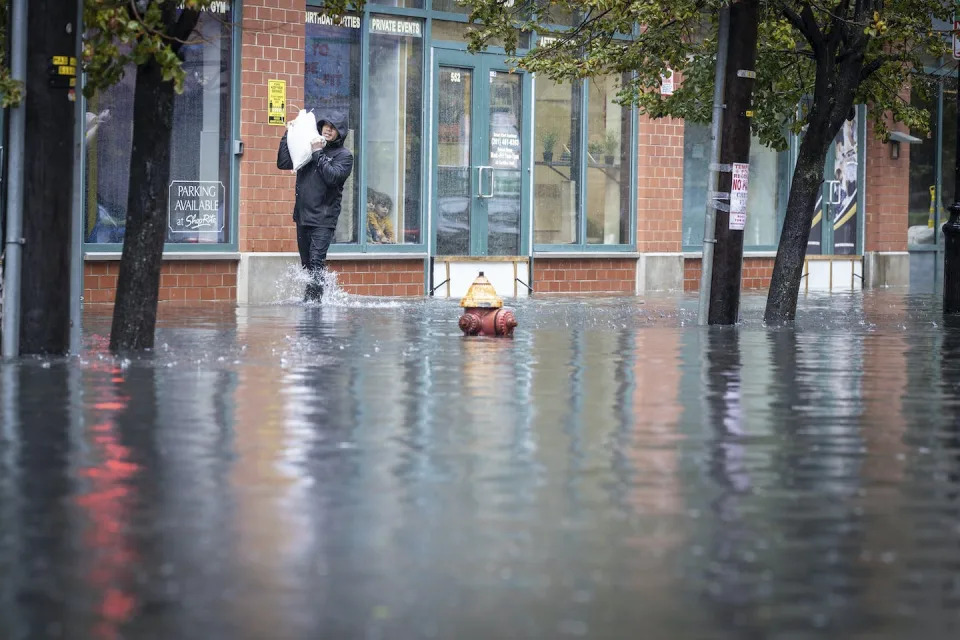Sossie Kasbarian, Senior Lecturer in Politics, University of Stirling
Fri, October 6, 2023
A United Nations mission finally arrived in Nagorno-Karabakh on October 1 to find its towns and villages almost completely deserted. Two weeks after Azerbaijan launched an all-out military assault on the disputed territory in the south Caucasus, the Armenian government has said there are now almost no ethnic Armenians left in an area they have lived in for more than two millennia.
The only people left are reportedly either too old, too poor, too remote or too infirm to flee to safety along the Lachin corridor to Armenia.
Before the military assault, Armenians living in the enclave had been trapped and living under siege since December 12, 2022. Azerbaijan established an illegal blockade of the narrow land bridge connecting Nagorno-Karabakh with Armenia, blocking supplies, including food and medicine.
After more than nine months, having reduced the population of 120,000 to near starvation, Azerbaijan launched a military assault on September 19. The attack killed an estimated 200 Armenian troops and seized control of strategic high ground around the enclave.
Under the terms of the ceasefire that followed, both Armenian troops and the 2,000 Russian peacekeepers were required to disarm and disband. Armenians were given the “choice” of “reintegration” into Azerbaijan.
These sanitised terms mask a violence and dispossession that the pictures in the media last week can only hint at. The queues of desperate Armenians fleeing were so long that they could be viewed from space.
Dehumanisation of Armenians
It was always highly unlikely that any Armenians would “choose” to stay under Azeri control of Nagorno-Karabakh. The regime of President Ilham Aliyev does not tolerate criticism or plurality of voice among its own citizens.
So Azerbaijan’s pledge “to protect the rights and safety of ethnic Armenians” has a hollow ring. Azerbaijan is rated as a “consolidated authoritarian regime” by US-based democracy think tank Freedom House, which rates it at a paltry nine out of a possible freedom score of 100 and judges it as “not free”.
For decades, the Aliyev regime has promoted ethnic hatred of Armenians. Azerbaijan has actively worked for the eradication and appropriation of its Armenian religious and cultural heritage. This was referred to in a recent report as “the worst cultural genocide of the 21st century”.
Meanwhile, atrocities committed by Azeri troops during the previous Nagorno-Karabakh war in 2020 have been well documented. The so-called “Military Trophies Park” in the Azeri capital of Baku, built as a memorial of the war, is filled with grotesque mannequins representing Armenians.
Ethnic hatred of Armenians is normalised by the government. A postage stamp issued in 2021 depicted the fumigation of Nagorno-Karabakh, implying that ethnic Armenians were a virus that needed to be eradicated (the stamp was not registered by the Universal Postal Union).
While Nagorno-Karabakh was being emptied, Azerbaijan reissued a map of Stepanakert, the capital city, with Azeri street names. One street has been renamed Enver Pasha, after one of the three Turkish architects of the Armenian genocide of 1915.
Caviar and energy diplomacy
Reporting of the conflict has largely overlooked the complex history and forces involved – as well as wider regional power struggles.
Instead, the global media has been lending credence to Azerbaijan’s script, referring to “anti-terrorist operations” against “separatists” and “ethnic Armenian rebels” to describe the Nagorno-Karabakh Armenians. This language obfuscates the expulsion of 120,000 Armenians from their ancestral homeland by a clear aggressor.
But Azerbaijan wields significant international influence thanks to its immense oil and gas wealth and the unqualified support of its “big brother” Turkey.
In addition, Azerbaijan uses all the propaganda weapons at its disposal. The Aliyev regime has become adept at courting political influence in the west through what has been dubbed “caviar diplomacy”. Events such as the Formula 1 Grand Prix also function as high-profile projections of soft power, effectively “sportwashing” Azerbajan’s corruption and human rights record.
A statement of solidarity with Nagorno Karabakh signed by more than 100 UK academics on September 26 singled out the UK’s close relationship with Azerbaijan and the Aliyev regime as providing “a useful veneer of ‘respectability’ to the laundering of funds and history”.
Azeri impunity
Experts in international law have described the forced exodus of Armenians from their homes as a “war crime”. And former UN independent expert Alfred de Zayas has called for recent events to be investigated by the International Criminal Court.
But since Russia’s invasion of Ukraine, Azerbaijan has become an essential source for western energy. The country now seems to have a protected status as what EU commission president, Ursula von der Leyen, calls a “crucial energy partner”.
The question of sanctions against Azerbaijan has been raised in the EU parliament and expressions of concern have been made by the Council of Europe and the US government. But any concrete action from the west is thought unlikely.
While Armenians were fleeing their homes, an advertisement from the UK’s Department for Business and Trade in The Telegraph of September 29 enthused about the 450 UK companies already doing business in Azerbaijan. It noted that the UK is the country’s largest foreign investor. On the same day, the government announced it would give one million pounds to the International Committee of the Red Cross (ICRC) as a response to “events” in Nagorno Karabakh.
The international spotlight now has understandably shifted to the plight of 120,000 refugees. But the focus on the humanitarian crisis risks overlooking the ethnic cleansing carried out by Azerbaijan and the web of complicity that enabled it.
The fate of Nagorno-Karabakh offers us a glimpse into the casualties of the so-called “rules-based order”, where economic and geopolitical interests and whitewashing campaigns converge to a point where ethnic cleansing is of little note and apparently no consequence.
This article is republished from The Conversation under a Creative Commons license. Read the original article.

The Conversation
Azerbaijan's capture of Nagorno-Karabakh opens up challenges for India in the South Caucasus
As India refigures its foreign policy to a region now changed by Armenia’s defeat in Nagorno-Karabakh, it almost certainly will have to seek out other, more stable avenues for its infrastructure ties given the potential of the INSTC project

(File) Ethnic Armenians gather in hope to leave Nagorno-Karabakh region for Armenia in the center of Stepanakert, Nagorno-Karabakh on 25 September, 2023. AP
Wile the latest round of the conflict over Nagorno-Karabakh, the long-disputed Armenian enclave within Azerbaijan, seems to have been over within hours of it having started ending with the Armenian population leaving their homeland, the reverberations will continue to resound. They had earlier faced a humanitarian catastrophe with the blocking of the Lachin Corridor.
The quick end can be attributed to a large degree by the unwillingness of Russia to get involved as it seems totally preoccupied by its commitments in Ukraine. However, the next fault line that seems to be emerging is Nakchivan, an enclave of Azerbaijan between Iran, Armenia and Turkey. Azerbaijan is demanding that Yerevan agree to the establishment of a corridor through Armenian territory that would connect Azerbaijan to Nakhchivan.
The South Caucasus region which lies between the Black Sea and the Caspian Sea comprising of Armenia, Georgia and Azerbaijan has been the region which has been the crossroads of the Persian, Ottoman and Tsarist empires as also the intersection between the Christianity and Islam.
RELATED ARTICLES
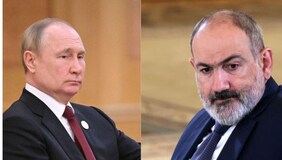
Armenia PM signals foreign policy shift away from long-standing ally Russia

Nagorno-Karabakh conflict: Pawns in Eurasian great game, Armenia and Azerbaijan must choose peace, not war
This land connects Asia to Eurasia apart from its significant natural resources. The conflict and emerging outcomes have both global and regional implications. Countries such as Russia, Iran, Turkey and Israel also have deep interests in this region, but it is also significant as far as India is concerned.
India’s broad engagement in the region
India does not have a publicly articulated policy for the South Caucasus — unlike “Neighbourhood First”, “Act East” or “Central Asia Connect”. However, since establishing diplomatic relations in 1992, India’s ties with Armenia have steadily grown. India has a Friendship and Cooperation Treaty with Armenia which was signed in 1995 further, the signing of a Comprehensive Strategic Partnership Agreement in 2019 has resulted in increased cooperation in trade, investment, defence and culture. Though, India’s provision of military assistance to Armenia has strained its relationship with Azerbaijan, Armenia extends its unequivocal support to India on Kashmir issue whereas Azerbaijan not only opposes but also promotes Pakistan’s narrative.
In the case of Azerbaijan, ONGC/OVL has made investments in an oilfield project in Azerbaijan and GAIL is exploring the possibilities of cooperation in LNG. Azerbaijan also falls on the International North South Transport Corridor (INSTC) route, connecting India with Russia through Central Asia. It can also connect India with Turkey and beyond through the Baku-Tbilisi-Kars passenger and freight rail link.
The conflict is essentially a conflict between two international principles viz., the principle of territorial integrity advocated by Azerbaijan and the principle of the right to self-determination invoked by Nagorno-Karabakh and supported by Armenia. When it comes to Armenia and Nagorno-Karabakh, though India had talked of a mediated settlement between the two sides, However, it supported Armenia through arms sales and by condemning Azerbaijan’s aggression in the region. This was not without reason as Azerbaijan’s long-time association with Pakistan had turned the conflict into one of the world’s more obscure proxy wars.
Lately, India’s has enhanced its strategic partnership with Greece which was viewed as a direct challenge to Azerbaijan as Armenia is a traditional ally of Russia and Greece and strain in relations between Turkey and Greece over Cyprus dominate their relationship though both are part of NATO. The recent visit of the prime minister to Greece was part of a broader strategy to diversify its partnerships in the region. India’s strengthening ties with Armenia and Greece are aimed at countering the alliance formed by Turkey, Azerbaijan and Pakistan by no longer relying solely on its traditional allies like Russia and Iran, instead seeking new alliances with countries that share its interests, such as Greece and Armenia.
India’s strategic approach of steadily building ties with Armenia, Greece and Iran reflect India’s increasing strategic interests in the Mediterranean region, which holds significant importance for its energy security due to its abundant oil and gas resources. Additionally, India aims to enhance its trade and investment relations with this region. This also serves as countering China’s expanding influence in the region.
India’s strengthening ties with Armenia and Greece have caused concern for Turkey, Azerbaijan and Pakistan, who have been working together to counter India’s influence in the Middle East and Central Asia
Region is crucial for India’s trade corridor
The South Caucasus region has also become key for India’s ambitions to build a transportation corridor linking it to Europe through the Iranian plateau, the International North-South Transportation Corridor, or INSTC.
As regards the INSTC, India needs a rail link to go from North Western Iran across the Southern Caucasus to either Russia or the Black Sea. In this regard, India (and Iran) have two options: one via Armenia’s Southern Syunik Province, and the other via the Caspian coast through Azerbaijan.
A key advantage of the INSTC is that it effectively outflanks Pakistan while accessing overland routes to Europe and Central Asia otherwise blocked. It also results in a closer relationship with Iran thereby countering Iran’s relationship with China and their Belt Road Initiative in the region.
In January 2023, at the Voice of the South Virtual Summit, Armenia’s Foreign Minister Ararat Mirzoyan mentioned that Armenia is interested in “advancing cooperation within the framework of North-South connectivity, as well as the Persian Gulf-Black Sea international transport corridor,” adding that “Armenia considers India’s potential and prospective role for these projects as quite significant.”
In April 2023, Armenia hosted the first trilateral meeting with Indian and Iranian officials, to facilitate a Black Sea-Persian Gulf trade route that would allow Indian goods to be exported to the West through Georgian ports
Yet the developments in the Nagorno-Karabakh conflict threaten the viability of the Zangezur including Turkey and Pakistan as well as Ankara’s expansionist pan-Turkic ambitions. corridor, an important corridor linking Azerbaijan to its Enclave, Nakhchivan. Recent comments by President Ilham Aliyev, of Azerbaijan, as well as Turkish President Erdogan’s speech at the UNGA, now suggest that the territorial viability of this corridor might be in question. Iran seems to have taken the threat to Syunik seriously enough to both reiterate Armenia’s control over the province which is internationally recognized and strengthen its troops in its northwestern border in response to the recent fighting.
Irrespective of whether conflict actually breaks out over the corridor, the fact remains that building a railway through a region that has the potential for conflict between Iran and Turkey, two of the largest militaries in the region, does not bode well for political stability in the long term.
Defence relationship
India’s support for Armenia shifted gears in 2022 with the provision of $250 million worth of arms and ammunition. The deal included significant export orders of Pinaka Multi-Barrel Rocket Launchers (MBRL), anti-tank missiles, rockets and ammunition to Armenia. In 2020, India also got a $43 million order to supply four Swathi weapon-locating radars to Armenia.
It was reported that this was the first time India has decided to export the Pinaka system to another country. Azerbaijan’s use of drones was a key reason why Armenia wanted the Pinaka system, since its “shoot and scoot” capability enables it to escape counter-battery fire.
India feels it can benefit from being an arms supplier to Armenia, filling a gap left by Russia’s strategic downsizing in the Caucasus due to its commitment in Ukraine.
In October 2022, Armenia’s Minister of Defence Suren Papikyan’s visited India and met the Defence Minister Rajnath Singh during the Defence Expo 2022.
In May this year, Armenia announced it was posting a military attaché to its embassy in New Delhi, tasked with deepening bilateral military cooperation. On 26 July Azerbaijan, summoned the Indian Ambassador and lodged a protest about India’s defence ties with Armenia saying that arming Armenia “at a time when Azerbaijan is negotiating a peace treaty with Armenia, the supply of deadly weapons by India opens the way to the militarization of Armenia and aggravates the situation, hindering the establishment of sustainable peace and security in the South Caucasus region.” The irony is that Baku continues to arm itself with Turkish and Israeli weapons for offensive purposes, but protests when Armenia takes a similar step to defend its borders.
Iran has played a crucial role. While Armenia is unable to purchase Iranian weapons due to fears of US and Western reactions, Tehran is facilitating the transit of weapons from India to Armenia.
On 23 September Armenia appointed a new Ambassador to India despite the ongoing chaos in Nagorno-Karabakh. The ambassador’s credentials, as both an Iran expert and as a regional diplomat in the South Caucasus, suggests the particular direction that Armenia wants to take bilateral relations.
An analysis from the Observer Research Foundation said; “India has overtly positioned itself on Armenia’s side in the Nagorno-Karabakh conflict, and has consequently opted to resist Azerbaijan and its backers including Turkey and Pakistan as well as Ankara’s expansionist pan-Turkic ambitions.”
Pakistan support for Azerbaijan
While Pakistan has been siding with Azerbaijan since the outbreak of the First Karabakh War in the early 1990s, India entered the picture as an arms provider to Armenia only after Yerevan’s defeat in the Second Karabakh War in 2020 with both now supplying arms to the principal combatants.
Pakistani support for Azerbaijan is intertwined with Islamabad’s close strategic relationship with Turkey, Baku’s primary patron. The Pakistani government was second after Turkey in recognising Azerbaijan’s independence following the Soviet collapse in 1991 and Islamabad has never acknowledged Armenia’s independence.
The Pakistani and Azerbaijani militaries have reportedly been conducting joint exercises since 2016 and maintain extensive strategic security contacts. According to some unconfirmed reports, Pakistani military advisers reportedly participated in the Second Karabakh War, providing tactical advice. Some observers also believe Islamabad may sell the JF-17 fighter jets to Azerbaijan. There are also reports that Pakistan may soon join Azerbaijan as a partner in a Turkish-led effort to develop a new-generation stealth fighter, dubbed Kaan.
Pakistan’s involvement is helping cement an Ankara-Baku-Islamabad alliance, informally dubbed the “Three Brothers”. The three countries all supposed democracies are predominantly Islamic. The fact that all three are engaged in territorial and ethnic conflicts also acts as a binding agent, encouraging them to assist each other strategically and diplomatically.
By supporting Azerbaijan militarily and diplomatically Pakistan has played a decisive role in stymying India’s policies in the South Caucasus. The strategy has its drawbacks as Pakistan is now linked with a country that is being condemned internationally due to its aggression.
Conclusion
While it seems difficult for India to publicly endorse Nagorno-Karabakh’s right for self-determination in view of the possible repercussions it can have for India as Pakistan may twist the support by making erroneous connections with Kashmir. India has done little to indicate support for Armenia, or even condemnation for Azerbaijan’s actions with the exception of the meeting of External Affairs Minister S Jaishankar with the Foreign Minister of Armenia, Ararat Mirzoyan in the UN General Assembly.
As India refigures its foreign policy to a region now changed by Armenia’s defeat in Nagorno-Karabakh, it almost certainly will have to seek out other, more stable avenues for its infrastructure ties given the potential of the INSTC project. It is not as if India lacks alternative options and maybe the IMEC could be a viable option. The world now needs to focus on the Zangezur corridor and Nakhchivan the two-time bombs that are now likely to get activated.
The author is a retired Major General of the Indian Army. Views expressed in the above piece are personal and solely that of the author. They do not necessarily reflect Firstpost’s views.
Opinion | Distraction of the Ukrainian War
Has Enabled Azerbaijan Achieving a Brutal
Outcome
Written By: Maj Gen Jagatbir Singh
News18.com
OCTOBER 03, 2023,
New Delhi, India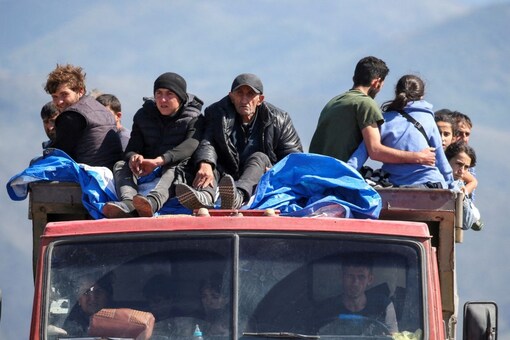
Refugees from the Nagorno-Karabakh region ride in a truck upon their arrival at the border village of Kornidzor, Armenia. (Image: Reuters)
While the focus of the West continues to remain on Ukraine, there is a bigger long-term failure here, in their inability to prevent the violence and get the Armenians and Azerbaijanis to agree on an equitable resolution to this bitterly contested conflict
The third war over Nagorno-Karabakh, the long-disputed Armenian enclave within Azerbaijan, ended almost as soon as it began. The Azerbaijani ‘anti-terror operations’ began on the afternoon of September 19 with artillery and drones and within 24 hours, the Karabakh Armenians, a population that has been pushed to the brink of starvation by a months-long economic blockade, capitulated, leaving Azerbaijan in effective control of the territory.
In scenes reminiscent of the Balkans in the 1990s, images of convoys of cars filling the mountain road from Karabakh to Armenia carrying thousands of ethnic Armenians leaving their homeland with as much as they can carry are flooding cyberspace. A region that has witnessed many such upheavals over the years faces yet another round of de facto ethnic cleansing.
While the focus of the West continues to remain on Ukraine, there is a bigger long-term failure here, in their inability to prevent the violence and get the Armenians and Azerbaijanis to agree on an equitable resolution to this bitterly contested conflict.
For the local population, the pendulum has swung since the collapse of the Soviet Union from euphoria, siege, victory, defeat and this outcome marks a bitter end and the complete destruction of a project that began in 1988 when the Armenians of Karabakh first tried to split away from Soviet Azerbaijan. The present loss of this territory and the consequent eviction of its people with centuries-old Armenian history and heritage is no doubt a brutal outcome.
The Azerbaijanis have called for the dissolution of all political structures in the territory — the local Presidency, Parliament, and elected Mayor — and are not offering any kind of political autonomy. In contrast, President Ilham Aliyev of Azerbaijan told the Karabakh Armenians that an earlier offer of status had “gone to hell” and what was left on the table were as yet undefined “educational rights, cultural rights, religious rights, and municipal electoral rights.”
Under those terms, some older people might choose to stay in Nagorno-Karabakh, and thousands of Azerbaijanis who lived there up until 1991 might return. But little or nothing will remain of all the local institutions built there over three decades.
Although the enclave had in theory been under the protection of Russian peacekeepers, Russian guarantees ended up being worthless. Russia has instead brokered a deal whereby the local population agreed to a full disarmament of their own “defence forces,” numbering several thousand men and to begin talks over their full “reintegration” into Azerbaijan. It has intervened to broker a ceasefire, the price for which is that Russia gets to keep its peacekeeping force on the ground and thereby a foothold in Azerbaijan; and to push Western mediators — the EU and US — further to the margins.
CROSS ROADS OF HISTORY & GEOGRAPHY
The modern maps of the South Caucasus were drawn between 1918 and 1921, during and after World War I. Then, Armenians and Azerbaijanis fought over the disputed territories of Karabakh, Nakhchivan, and Zangezur, and Turkish and Russian armies marched in and out. In 1923, the Soviet Union established the Nagorno-Karabakh Autonomous Oblast—home to a 95 per cent ethnically Armenian population within the Azerbaijan Soviet Socialist Republic. Nagorno-Karabakh’s regional legislature passed a resolution in 1988 declaring its intention to join the Republic of Armenia, despite its official location within Azerbaijan.
The South Caucasus region which lies between the Black Sea and the Caspian Sea comprises Armenia, Georgia and Azerbaijan apart from Southern Russia. This region has been the crossroads of the Persian, Ottoman and Tsarist Empires as also the intersection between Christianity and Islam. Armenia is mainly Christian, with 97 per cent of the population belonging to the Armenian Apostolic faith, one of the oldest Christian churches founded in the first century CE. Azerbaijan is 96 per cent Muslim, with 65 per cent of the people adhering to Shia Islam and the rest to the Sunni faith. Four-fifths of Georgia is Orthodox Christian.
During the Soviet era, the roughly 1,700-square-mile region of Nagorno-Karabakh, whose population has been predominantly Armenian, was an autonomous Oblast of the Azerbaijan Soviet Socialist Republic. After the breakup of the Soviet Union in 1991, it was internationally recognised as part of the Republic of Azerbaijan, which completely surrounded it. However, fighting erupted between Azerbaijan and local Armenian forces supported by Russia. Internationally sponsored negotiations tried to balance Azerbaijan’s territorial integrity and its viability as a state with the aspirations of the Karabakh Armenians.
Back in 1992, when the first war expanded to full-scale fighting, the Foreign Ministers of the Organisation for Security and Cooperation in Europe met in Helsinki and called for a conference to be held in Minsk to resolve the conflict. It was to be attended by all parties, including “elected representatives of Nagorno-Karabakh and others”—in other words, both Karabakh Armenians and Azerbaijanis. But in the end, the conference never happened.
The security organisation’s mediation was supposed to be based on the principles of the Helsinki Accords, the 1975 agreement between the West and the Soviet Union that formally established territorial integrity, self-determination, and the non-use of force as essential to preserving European peace. In practice, none of these principles were honoured. In fact, international commitment to this conflict was always under-resourced because the South Caucasus was considered too marginal.
In 1994, Russia brokered a ceasefire, and for the next 25 years or so, a stalemate was held in which forces backed by Armenia and Russia effectively controlled the territory. After 1998, the Karabakh Armenians were no longer represented in the talks, as the then President of Armenia, Robert Kocharyan, was a Karabakh Armenian who said he could negotiate on behalf of his people. Diplomacy was reduced to secret talks between Azerbaijani and Armenian leaders.
In 2017, the Karabakh Armenians, encouraged by Armenian nationalists in the region and the Armenian diaspora, formally renamed their region Artsakh, an Armenian name dating back to ancient times. The implication was that Azerbaijan should give up on not just Nagorno-Karabakh but also surrounding regions under Armenian control.
Azerbaijan also showed little interest in substantial negotiations focusing instead on reconquest. For more than thirty years, no Azerbaijani leader negotiated directly with the Karabakh Armenians or put down any formal proposals for their future within Azerbaijan. Western mediators came up with peace formulas but were never able to offer the “boots on the ground” to enforce them. All this gave Russia the strongest leverage, and at the end of the 2020 war, it duly became the only outside power to intervene directly and put boots on the ground in the form of peacekeepers.
In 2020, however, the momentum in the conflict, which seemed to have been frozen, shifted decidedly toward Azerbaijan, which won a clear-cut military victory over Armenia during a short but consequential war over the territory which is widely remembered in military circles for the devastating role played by the Turkish Bayraktar drones against the Armenian tanks. That outcome heightened the latent tensions among the countries in the region at a time when Russia, which has traditionally been the most important outside actor in the conflict, was distracted by its commitment in Ukraine.
UNUSUAL ALLIANCES AT PLAY
The long-running conflict between Armenia and Azerbaijan over the disputed region of Nagorno-Karabakh has created partnerships in the South Caucasus that cut across religious, ethnic, and geopolitical lines in surprising ways. Iran, which is ruled by Shiite clerics, has provided an economic lifeline to Christian-majority Armenia, whose primary backer has for long been Russia. Meanwhile, Israel and Sunni-majority Turkey have formed a strategic alliance with predominantly Shiite Azerbaijan. And the two Shiite-majority countries in the mix — Iran and Azerbaijan — remain locked in a bitter, decades-long dispute over territory and identity.
As Israel’s ties to Azerbaijan deepened, since 2016, Azerbaijan has received nearly 70 per cent of its arms imports from Israel, which in turn purchases 40 per cent of its oil from Baku. Iran became concerned that Israel is turning Azerbaijan into its proxy and using it as a launchpad for operations against it including the 2018 theft of information regarding its nuclear archive.
In recent years, the growing proximity of Israel and the Persian Gulf Arab monarchies has also been of concern to it. The Iranians now fear that a similar dynamic is taking shape between Israel and two countries with predominantly Turkic populations, Turkey and Azerbaijan. The perceived threat of being sandwiched between an Israeli-Gulf Arab bloc to the South and an Israeli-Turkic bloc to the North, combined with domestic unrest in Iran, led to Iranian support for the Armenians. They also feared the instigation of separatism among the Iranian Azeri population.
FALLOUTS OF THE WAR OF 2020
The War of 2020 led to 7,000 deaths in just six weeks of fighting. It also re-shifted the ethnic balance in the region. On one hand, by recapturing the area of Azerbaijan surrounding Nagorno-Karabakh, which had been devastated and occupied by Armenian forces for two and a half decades, Baku’s victory allowed hundreds of thousands of Azerbaijani refugees to return to their homes. For the remaining 12,000 Karabakh Armenians, the situation was ever more precarious. The three-mile Lachin Corridor — their only supply route to Armenia — a slender and vulnerable lifeline was entirely dependent on the small Russian peacekeeping force, and by extension, Russia’s relations with Azerbaijan to keep the road open.
Once the war in Ukraine began in February 2022, Russia was distracted and its priorities in the Caucasus shifted. Azerbaijan, Russia’s main land route to the South, became a more important partner than Armenia, its traditional Christian ally in the region. This resulted in Azerbaijan sealing off the Lachin Corridor in December last year.
Having effectively lost control of Nagorno-Karabakh, Armenian Prime Minister Nikol Pashinyan started saying publicly that Armenia renounced its territorial claims on the region. Instead, the formula he adopted in talks with Azerbaijan facilitated by the EU was that the issue was now “the rights and security” of the Karabakh Armenians. In turn, President Aliyev frequently used the words “territorial integrity” and used the war in Ukraine as cover. Western officials told him that the territory would return to Azerbaijani jurisdiction but that patience was needed. As recently as mid-September, he received calls from the US and other Western officials warning him against resorting to military force.
Domestic logic also dictated Aliyev’s actions. For two decades, he has been the leader of an authoritarian state. Hence why should he agree to Western demands for a model of conflict resolution that compels him to offer autonomy to a national minority community, weakening his hold on power?
Moreover, analysts feel that Aliyev believes that Turkey and Russia, not the West, are the only powers he needs to take seriously. In the present case, both Turkey and Russia see the utility of limiting Western engagement in the South Caucasus, a region where they have traditionally wielded influence.
Turkey, Aliyev felt, would support his effort to take full control of Nagorno-Karabakh, Russia would not prevent it, and the West, with very little leverage in the region, would be a bystander.
FLURRY OF DIPLOMATIC ACTIVITY
In a flurry of diplomacy in May 2023, the US, EU, and Russia all hosted peace talks. US Secretary of State Antony Blinken hosted four days of talks with the Foreign Ministers of Armenia and Azerbaijan and said they made steps toward normalisation and peace. Shortly after, European Council President Charles Michel mediated discussions in Brussels between Armenian Prime Minister Nikol Pashinyan and Azerbaijani President Ilham Aliyev, describing them as “productive” talks.
Then, in late May, Russian President Vladimir Putin hosted a trilateral meeting with the two leaders to discuss the reopening of transportation links between Armenia and Azerbaijan, though no agreement was reached. After three days of US-held talks on Nagorno-Karabakh in late June, Blinken applauded “further progress” toward a peace agreement and said both sides showed a willingness to negotiate seriously.
On September 14, a senior Biden administration official said, “The United States will not countenance any action or effort—short-term or long-term—to ethnically cleanse or commit other atrocities against the Armenian population of Nagorno-Karabakh.” Five days later, Azerbaijan launched its military operation. On September 21 at the UN, the German Foreign Minister said, “The displacement and forced exodus of ethnic Armenians from Karabakh are not acceptable,” while the US Ambassador called for an international mission on the ground.
But the fight for the rights of Karabakh Armenians seems to be over before it began. Presently it is difficult to imagine an outcome that would protect their historic legacy and assure the survival of the Armenians in Nagorno-Karabakh. The cost of their defeat will reverberate for decades to come.
NAKHCHIVAN: THE NEXT BOILING POINT
A potential outcome of Azerbaijan’s victory is the future of Nakchivan, an enclave of Azerbaijan between Iran, Armenia, and Turkey. Azerbaijan is demanding that Yerevan agree to the establishment of a corridor through Armenian territory that would connect Azerbaijan to Nakhchivan. President Ilham Aliyev called this passage “a historical necessity . . . [that] would happen whether Armenia wants it or not.”
Such a corridor would cut Iran’s access to Armenia as the two countries would no longer share a border. Iran, which views Armenia as a critical link with Eurasia, had threatened to use military force against any changes to the internationally recognised borders of the region. During a meeting with Turkish President Recep Tayyip Erdogan last July, Ayatollah Ali Khamenei warned against creating a barrier between Iran and Armenia by blocking what “has been a communication route for thousands of years.”
Even though most of its provisions lie in tatters, the trilateral Ceasefire brokered by Russia in November 2020, and co-signed by Aliyev, Pashinyan, and President Vladimir Putin has as one of its provisions, Border Guards from Russia’s FSB to protect the transport corridor across Armenia to Nakhchivan, a region being referred to as Western Azerbaijan.
This is where the next battleground lies. It is felt by some that the UN backing should put this under a broader international umbrella but Azerbaijan and Russia may resist this. The crisis in the South Caucasus has the potential to spiral out of control and also draw Iran and Russia closer.
CONCLUSION
The Karabakh conflict has been central to the modern national identities of both the Armenians and the Azerbaijanis. Both sides still use language that excludes the other: for example, the Armenians call Karabakh by the old Armenian name Artsakh, implying a region without Azerbaijanis, and the Azerbaijanis call the Armenian-populated town of Stepanakert by an Azerbaijani name, Khankendi.
The return to violence is also a reminder of the failure to establish a European security and rights framework for the South Caucasus. Western diplomats have for decades backed an approach to Nagorno-Karabakh built on international legal principles and modelled on resolving the Balkan conflicts. In theory, such a settlement would involve international peacekeepers, war crimes tribunals, political autonomy, and the eventual peaceful coexistence of Karabakh Armenians and Azerbaijanis. Russian commitments in Ukraine have also limited its capacity to project power in its neighbourhood.
To quote Lenin, “Having gone a full circle we are back to square one”. Once again violence, not diplomacy, has played a role in determining key outcomes. Unfortunately, the importance of history and geography in geopolitics cannot be ignored and small players take full advantage of settling lingering disputes when major players are distracted. The pulsating ripples of the Ukrainian conflict have undoubtedly exposed yet another faultline.
The author is an Army veteran. Views expressed in the above piece are personal and solely that of the author. They do not necessarily reflect News18’s views.

